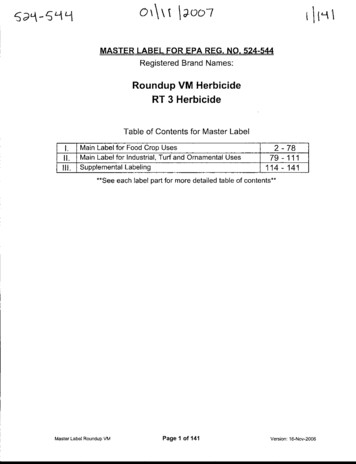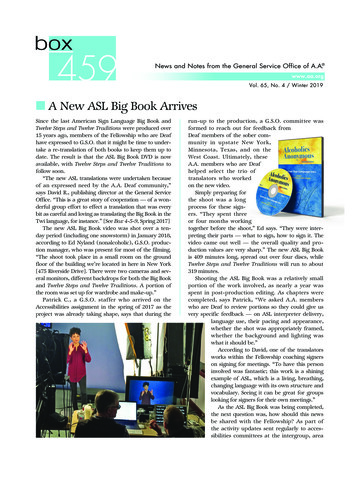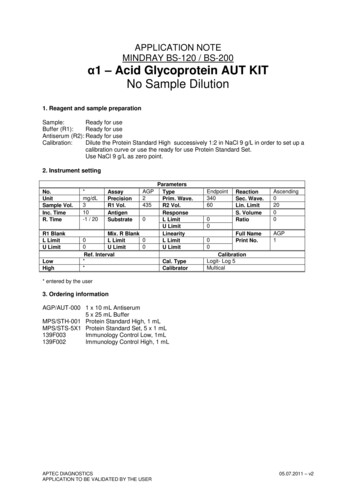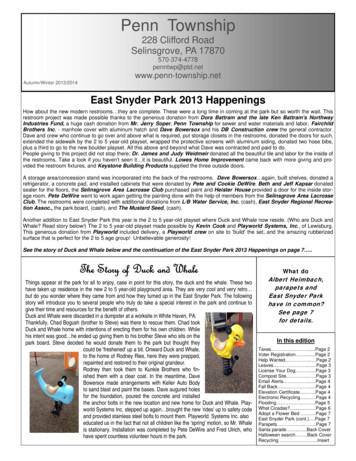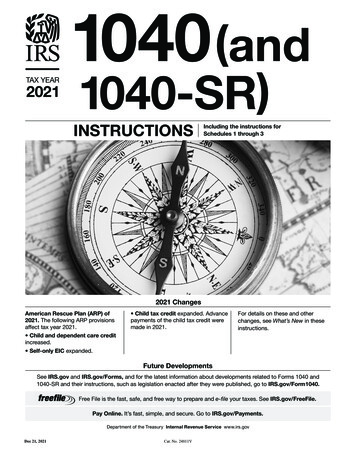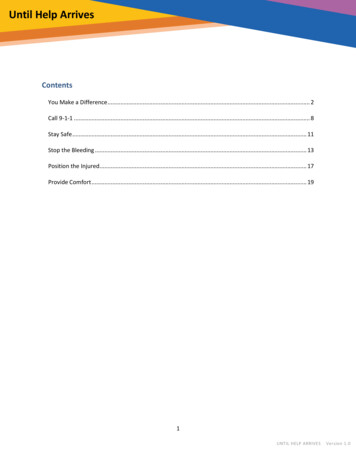
Transcription
Until Help ArrivesContentsYou Make a Difference . 2Call 9-1-1 . 8Stay Safe . 11Stop the Bleeding . 13Position the Injured. 17Provide Comfort . 191UNTIL HELP ARRIVESVersion 1.0
Until Help ArrivesYou Make a DifferenceInjuries can happen at any time. In fact, you neverknow when you might find yourself in a situationwhere someone, a stranger perhaps, needsimmediate medical help for a life-threateninginjury. You are the most important help available tosomeone with a serious, life-threatening injury.When someone experiences a life-threateningemergency, the first care they can get can be thedifference between life and death.Over the next 30 minutes, we’ll explain why youshould help, how you can help, different reactionsyou might experience in the midst of anemergency, and how to mentally prepare yourselfto help as much as possible.The following tells the story of an event thatbrought two strangers together. It is a powerfulreminder that at a moment’s notice, any one of usmight find ourselves in a situation where we are thehelp until help arrives. In the end, this film calls onall Americans to remake what it means to be abystander. The following is the transcript of thevideo entitled, “A Perfect Stranger.”2UNTIL HELP ARRIVESVersion 1.0
Until Help ArrivesKinneil: It was a little strange to sit down to someone that you’ve never met before, and decide thatyou’re gonna grab their hand and tell them everything is okay.Angelia: I screamed. That’s all I remember doing at that moment. I knew I was going to wreck.Kinneil: I remember feeling like we had to do something immediately right now.Angelia: The day started out like any other day. It wasn’t cold. It wasn’t hot. My friend called me thatmorning and said, “I’m gonna take out my Harley, and you got your new bike, and so let’s just go outand have some fun.”Kinneil: All of a sudden, I see the woman on the motorcycle just flying through the air. I just remembersaying, “Stop the car.”Angelia: I remember getting thrown headfirst over the motorcycle. And I heard them say, “Don’t move.Please don’t move.” Blood was streaming down and it went on into the cutter. There’s still the mark ofthe blood.Kinneil: And then when we pulled up and saw her, blood was rushing down out of her leg and into thegutter. My husband’s cousin took his shirt off and immediately started applying pressure to stop thebleeding.Angelia: Kinneil was holding my hand. I remember that distinctly. She was saying, “You’re going to beokay.” And to hear those words was so important.Dr. Lutz: I really feel bystanders have a responsibility to act. Don’t be afraid. You’re not gonna hurtyourself. You’re not gonna hurt the patient. All you’ll do is help. Even if it’s just a comforting hand.Andrew: Doing something is better than doing nothing. That helps us more than they would everrealize. That can make all the difference between life and death.Kinneil: If you imagine yourself in a situation where you’ve been in an accident, you’re vulnerable;you’re frightened, think about what you would want.End Video.For more information about Angelia and Kinneil’s back story, go nger?lang en US3UNTIL HELP ARRIVESVersion 1.0
Until Help ArrivesIf something happens where people are injured,act quickly and with a purpose. Remember to call911 as soon as possible. Then, move the injuredaway from any remaining danger, and then, doanything within your ability to keep them alive:apply pressure to stop bleeding, reposition themto help them breath, talk to them and providecomfort if they are conscious.It's important to note that if you think an injured person is in immediate danger that could result inadditional injuries, try to get them out of harm's way before calling 9-1-1. If you are able, you shouldhelp them and then call, or get someone else to help them or call.The typical EMS response time is only about 6 to 9minutes. However, life-threatening injuries can killwithin minutes, before medical responders arrive!The following is the transcript of the video entitled,“You are Part of Our Team.”Dr. E. Reed Smith: Any first responder will tell youthat it is rare, really rare, to show up on any scenewhether it’s a fire, whether it’s someone sick,whether it’s a cat in a tree, where someone isn’ttrying to do something. We do a pretty good job as professional medical response; we do a good jobgetting there quickly.But we get there and nothing’s been done. When we get there and there’s been a huge time lag. Whenyou get there and it’s been 30 minutes, and that person’s now cold and we know that gettinghypothermic, getting cold, when you’re traumatically injured kills you, we know that If a person’s in aposition where they can’t breathe well , right and they haven’t been getting enough oxygen, that killsyou we know that. 30 minutes is a long time. The person who’s bleeding and continues to bleed andthere’s a giant puddle of blood on the ground which should be inside that person’s body So can we keep them alive? Maybe. But it’s going to be way harder if we don’t have the citizen helpingus out. You know it’s a team, we’re a team, we’re here to help you - we need you to help us.Clare Burley: People are afraid because they don’t have formal training, that they might make asituation worse. Really it’s very very hard to make the situation worse. If you’re in a situation wheresomeone is suffering some kind of life threatening emergency, it’s pretty hard to make it worse for themthan it already is. It’s much better to try to do something, you’re very unlikely to cause them harm. Soit’s better to at least give it a shot, it’s a difference between life and death for that person. We’re quickbut we’re not that quick.4UNTIL HELP ARRIVESVersion 1.0
Until Help ArrivesAnne Marsh: If people knew that they could intervene and do something immediately, would helpenormous numbers of people. The worst thing you can do is just stand by and do nothing. End of video.It’s important to note that you won’t get in troublefor helping! Good Samaritan Laws help protectthose who help until help arrives. State lawsknown as “Good Samaritan” laws generally protectpeople who provide uncompensated medical careor assistance during a life-threatening situation.These laws vary by state, but their shared aim is toprotect people who provide care in a prudent andreasonable manner to ill or injured persons.When you call 911, you are starting the first part ofthe emergency medical system. The Chain ofSurvival is how the emergency medical systemflows to keep people with life-threatening injuriesalive. It starts with YOU.In a life-threatening emergency, you willexperience physical and psychological effects thatmay include distortion of time, distortion of sense– like having tunnel vision or muffled sounds. Youradrenaline may kick in and activate your fight orflight response, meaning you may experience achange in body temperature, feel shaky, and/orlose control of other body functions. You may alsofeel nauseous. These are all normal reactions tostress, and most people will experience them. In an emergency, your brain will search your previousexperiences for an anchor that tells it how to respond. Training, including mentally rehearsing how youwould react, provides a hook for your brain and speeds your assessment process, making your responsefaster.5UNTIL HELP ARRIVESVersion 1.0
Until Help ArrivesProfessional first responders train regularly tomake their reactions to emergencies secondnature; many report doing their jobs during a crisis‘without thinking about it.’ Even the process oftalking through how you would respond willimprove your response time; talk with your family,friends, and workers about how you wouldrespond in certain situations.Let’s see what you remember. We discussed whatyou should do when you arrive at the scene of alife-threatening situation. Select the best answersfor the following scenarios.There’s been a car accident. It looks like people areinjured. A conscious victim is bleeding in front ofyou. What should you do? Run away to safety? Call911? Go find somebody else to help? The correctanswer is call 911.You’ve stopped the flow of blood, but there arestill no first responders around you are starting tofeel nervous and doubting yourself. What shouldyou do? Call for the assistance of someone else,you need to get a clear head first? Since thebleeding has stopped, run away and look for help?Continue working with the injured person, realizingthis is a normal reaction to stress? The correctanswer is continue working with the injuredperson, realizing this is a normal reaction to stress.You just learned why and how you should helpwhen you encounter someone who has beeninjured. Kinneil didn’t just stand by, she caredenough to stop and provide a comforting hand andreassuring voice. You can do the same thing.Remember, you may be the only help available tosomeone with a serious, life-threatening injury.6UNTIL HELP ARRIVESVersion 1.0
Until Help ArrivesOver the next several minutes, we’ll review waysyou can help. Of course, always call 9-1-1. Keep inmind your safety and the safety of the injured. Ifsomeone is bleeding, take action to stop thebleeding. You may need to position the injured sothey can breathe more easily. And finally,providing comfort and support can be just asvaluable as providing medical support.End of Topic.7UNTIL HELP ARRIVESVersion 1.0
Until Help ArrivesCall 9-1-1Let’s start with calling 9-1-1. We all think we knowhow to call 9-1-1 during an emergency, but haveyou ever really had to do it? You might besurprised at how stressful it can be. Here are sometips for how to do it well so the operators can getthe right kind help to you as soon as possible.This topic will go over the questions that a 911operator will ask and will explain how you canwork together with your operator to provide thebest possible response.No matter what, you should ALWAYS call 911! 911operators are highly trained and will help you workthrough the situation, tell you what to do to help,help you to focus, and instruct you on how to be assafe as possible. Always make the call even if youthink others may have done it already.When you make a 911 call, it’s normal to feelstressed; you might be surprised to find that thishappens even when you practice! Take a deepbreath and lean on the operator. They will ask youspecific questions that help them send the righttype of help to you. Depending on the situation,they may give you specific instructions. Followtheir lead and let them coach you!8UNTIL HELP ARRIVESVersion 1.0
Until Help ArrivesOperators may ask you some common types ofquestions about where you are, what is happening,who else is involved, and if the emergency is stillhappening, for example, if there is still a fire in thebuilding or if there is a shooter nearby. It’s ok ifyou don’t know the answer, don’t worry aboutknowing exactly what to say or sounding silly infront of the operator. Just give them as muchspecific information as you can, for example, if youare in a building, what floor number are you on, are you nearby any signs or other landmarks that willhelp responders to find you? This type of information can be really important to the people coming tohelp you.Let’s see what you remember. We just discussedthe importance of calling 9-1-1. Use theinformation you learned to select the best answersfor the following scenarios.In which situation should you call 9-1-1?Scenario 1, you see a car crashed into a telephonepole with someone unconscious.Scenario 2, you see someone standing around theircar which has had its tires stolen.The correct answer is scenario 1- when you seesomeone unconscious after an accident.What is the first question you should be preparedto answer from the 911 operator? A. How old areyou? B. Where is your emergency? C. Can you getsomeone else to help? The correct answer is B,where is your emergency?The operator is asking you several questions thatyou aren’t able to answer. You should: A. Say youcan’t help and that you are going to try to findsomeone else to give the phone to. B. Explain tothe operator that they are asking too manyquestions and that you can’t answer them. C. Takea deep breath, and provide as much information asyou can no matter how non-specific it may be.The correct answer is C.9UNTIL HELP ARRIVESVersion 1.0
Until Help ArrivesYou just learned why it’s important to call 9-1-1.One of the best things you can do when you comeupon what may be a life-threatening situation, is tocall. Stay on the line with the operator, and answertheir questions as calmly as you can. 9-1-1Operators will help you get the help you need.End of Topic.10UNTIL HELP ARRIVESVersion 1.0
Until Help ArrivesStay SafeDuring a life threatening situation, you need to beaware of what’s happening around you, before youtry to offer assistance. You can’t help anyone if youget hurt yourself.In this topic, you’ll get some tips on how toapproach an emergency and what to keep an eyeout for when you are helping others.Remember that you’ll probably feel the effects ofstress when dealing with an emergency .so it’svery important pause, and try to gather as muchinformation as you can using all your senses. Forexample what do you see? What’s happeningaround you? What do you hear? Any voices,screams, noises that cause concern? And what doyou smell? Any fumes or chemical smells?It’s important to help when you can, but it’s alsoimportant to be as safe as possible. It all comesdown to using your best judgement before takingaction! You want to decide if you are safer whereyou are or somewhere else, and if you do decideto leave, if you need to consider if you can takesomeone else with you.11UNTIL HELP ARRIVESVersion 1.0
Until Help ArrivesIf you decide to go, and you want to take aninjured person with you to get them away fromcontinuing danger, you want to move smartly.What does that mean? It means using what’saround you- like other people, a cart or vehicle,chairs, blankets, etc. OR using a smart carry- likethe ones pictured. You want to use the leastamount of energy possible, especially if you needto move multiple people.Remember, if someone is in grave danger, the goal is to get them away from that danger by whatevermeans possible, so when in doubt, do whatever you can. Think about someone lying in the middle of abusy street; if they stay there, they are in great danger of being hit by a car so you want to get them outof traffic however you can, including dragging them if that’s the best way to get them off to the side ofthe road. Once they are safe, call 9-1-1.Let’s see what you remember. Earlier we had youexplore a flow chart of questions to ask yourselfprior to providing care. Work through the flowchartfrom left to right. Based on the “yes” or “no”responses to the questions you should ask, choose”Leave,” or “stay.”You have learned why it’s important to be aware ofyour surroundings during a life threateningsituation. Remember to keep yourself safe, so thatyou are able to help others.End of Topic.12UNTIL HELP ARRIVESVersion 1.0
Until Help ArrivesStop the BleedingBleeding is a fast killer; one of the easiest and mostimportant things to do is to stop bleeding asquickly as possible.The following topic discusses life-threateningbleeding and how to control it; either by applyingfirm, steady pressure or if necessary, using atourniquet.Transcription of video, “Time is Crucial”.Dr. E. Reed Smith: If you see somebody and you’relike “Wow that’s a lot of blood!” or “Wow that’s alot of bleeding!” you should do something. That’ssignificant bleeding. What happens is it’s all aboutthe amount of blood loss. We have a set amount ofblood in our bodies based upon your size andother things, generally 5 liters, 5-6 liters of blood.We know from medical science and studies at what point your body starts to have not enough blood. Tothe point where it’s causing physiologic problems, it’s causing problems. That starts around 500cc orabout half a liter to a liter of blood. If you lost 2 liters of blood, and 3-5 minutes is pretty fast to lose thatamount, it’s more like 10-15 minutes in bad bleeds. Once you get to that point and beyond that,potentially, you can go into a state of what we call irreversible shock. And essentially the tank doesn’thave enough gas in it to keep the engine running.13UNTIL HELP ARRIVESVersion 1.0
Until Help ArrivesIrreversible shock is irreversible. Which means it doesn’t matter what we do. It doesn’t matter how goodyour trauma center is, it doesn’t matter how good your doctors are, it doesn’t matter how good yourparamedics are, it doesn’t matter. Once you start that physiologic process of irreversible shock, itcontinues. We can’t break that cycle, and you will die, or that person will die. The point- the onlytreatment for irreversible shock is prevention of irreversible shock. Don’t let them get to that point. Thatblood belongs in the body; it doesn’t belong on the street. It belongs in the body, so let’s keep it there.No matter how we do it, let’s keep it there. End of Video.Thanks Dr. Smith! When someone is bleeding badly,you need to stop the bleeding right away so theydon’t go into shock. When your body loses abouthalf its blood volume, about the amount pictured inthese liter bottles, a person WILL die, even if youeventually make it to a hospital and receive medicalcare. You can lose that amount of blood withinminutes so every drop of blood counts. So how canyou stop the bleed?Transcription of video, “How Do You Stop TheBleeding?”Dr. E. Reed Smith: Pressure stops bleeding, it’s oneof those things in medicine we’ve known a longtime. It’s one of the things that, it’s a truth inmedicine that’s true today and it’ll be true in ahundred years. Pressure stops bleeding. So what wereally want the citizen to do, how do you stopbleeding if you’re on the side of the road or in the middle of the woods and waiting for someone tocome help you? Is you have to put pressure on the bleeding. There are a couple things about that thatpeople need to understand.Number one: You got to understand a little about the anatomy. The major blood vessels, the ones that’llcause bleeding to the point where you’re going to die, are always deep under the skin near the bone. Sothere always down and they run along major bones. That means you have to apply a lot of pressure. It’snot just a little bit of pressure; it’s a significant amount of pressure.Number two: It may cause some discomfort and that’s okay, you’re not doing any damage, you’re nothurting them; you’re actually saving them.14UNTIL HELP ARRIVESVersion 1.0
Until Help ArrivesAnd number three: You have to hold it for a long time. You have to make sure you’re holding pressurefor long enough that the clotting process starts. How long is that pressure? As long as you can- until weget there or you can’t hold it anymore. What people have a tendency to do is they want to come up andput a bandage on a bleeding wound. A bandage doesn’t stop bleeding; all it does is soak up blood. Andagain, that blood that it’s soaking up into that bandage should be in your body, it shouldn’t be beingsoaked up into that bandage; we want it to stop. So before you put the bandage on, before you makesomething look pretty, you got to put pressure on it. And that pressure is what works.If you don’t get the bleeding stopped, even if you slowed the bleeding, maybe you buy that personenough time until we can get there and completely control the bleeding. And then some bleeding can’tbe controlled, the wounds are too big, the artery is too large, the vein to too large that’s where welook at tourniquets. And even still, if you have a wound that needs a tourniquet, I want to put pressureon it while I’m getting the tourniquet in place. Because if you’re free flowing blood while I’m working ongetting my tourniquet, you’re dying while I’m getting my tourniquet in place. We want to stop the dying.We stop the dying by stopping the bleeding with pressure and then we apply the tourniquet which thenfurther controls it. That’s the key. End of VideoThanks again Dr. Smith. Just for review, here arethe steps to control bleeding. First, you find thesource of the bleed. It may come from one place, ormultiple wounds. Second, if you have something toput in between the blood and your hands, like apair of gloves, a piece of cloth, or even a plasticbag, you should use it to keep things as sanitary aspossible. Third, apply firm, steady pressure directlyon the source of the bleed. Push hard to stop orslow down the bleeding, even if it’s painful to the person you are helping! Finally, keep pressure untilEMS arrives and takes over; use other people to help you if you get tired.Think of the tourniquet as another way to applyfirm, steady pressure when the injury is to an armor leg, and the bleeding is so severe it cannot becontrolled otherwise. If you have access to atourniquet, you should practice using it (carefully)on a friend so you are familiar with it.15UNTIL HELP ARRIVESVersion 1.0
Until Help ArrivesThis is a step-by-step list on how to use a tourniquet.Let’s see what you remember. Dr. Smith discussedwhy it’s so important to stop the bleeding. Which ofthe following items would you use to stop heavybleeding if a tourniquet is not appropriate oravailable? A coat? A soft toy? A shirt? The correctanswer is a shirt.We also learned that a tourniquet is a way toprovide steady pressure to a bleed when it cannotbe controlled otherwise. In order to slow the rate ofthe bleed, what is the best place for the applicationof a tourniquet if the wound is located near theknee? On the wound? Above the wound? Below thewound? The correct answer is above the wound.You have learned why it’s important to stop thebleeding and how you can stop the bleeding. Youalso heard Dr. Smith talk about how quickly bloodloss occurs and what happens when somebody losestoo much blood. Remember to do what you can tokeep blood in the body, hopefully preventingirreversible shock. End of Topic16UNTIL HELP ARRIVESVersion 1.0
Until Help ArrivesPosition the InjuredPositioning an injured person correctly andcomfortably is one of the easy ways you can helpkeep someone aliveThis topic shows you how to position someone tohelp them breathe as easily as possible whetherthey are conscious or unconscious.We’ve all been told that when someone is sick,they should lie down but actually, if someone isconscious, meaning awake and probably talking toyou, let them sit or lie however they feel best. Thebody will automatically go to the best positionwhen someone is alert. If they are struggling tomove, simply help them to a more comfortableposition. Don’t force them to lie down or sit up,especially if they are trying to re-positionthemselves!What should you do if the person is unconscious,or not awake and able to respond? If the injuredperson is breathing, move them into the recoveryposition. If they aren’t breathing, and you are able,remove obstructions and perform CPR.17UNTIL HELP ARRIVESVersion 1.0
Until Help ArrivesIf you are helping an unconscious person, youshould move them into what’s call the “recoveryposition.” The recovery position is a way to placethe body on its side to keep the airway open andprevent choking.Let’s see what remember. We discussed theimportance of moving an unconscious person tothe recovery position. Select the best position forthe unconscious person in the following scenario.What is the correct position to place a seriouslyinjured person in? Rotate injured person onto side,Flip injured person flat on stomach, or attempt tosit the injured person up. The correct answer is torotate injured person onto side.You have learned how to position both a consciousand unconscious person. The most important thingto remember is to put them in a position that willhelp them breath as easily as possible.End of topic.18UNTIL HELP ARRIVESVersion 1.0
Until Help ArrivesProvide ComfortOffering comfort and kind, encouraging words canbe just as valuable as offering medical support.Survivors often remember the words and supportgiven by those around them.This topic will give you some tips on how to bestprovide comfort to people who are seriouslyinjured as well as those around them.Any time you help someone; always start by askingthem if you can help. You might start by sayingyour name and asking “How can I help?”, “What doyou need?”, or “What happened?” Try to keepthem calm and focused on you. Tell them what youcurrently know and what is going to happen next.Also help them understand what’s being done toassist or treat them if someone is attending tothem.If it’s comfortable for you, it’s also appropriate tooffer a hand to hold or a shoulder to lean against.Maintain eye contract, be patient andunderstanding, and if you have to move on toprovide aid to another person, tell them help iscoming.19UNTIL HELP ARRIVESVersion 1.0
Until Help ArrivesWhen people have serious injuries, it is veryimportant to keep them warm. Cover the personyou are helping up and if you can, put somethingbetween them and the ground.Even if it seems warm out to you, the injuredperson may be losing body heat which can lead tohypothermia. Keeping an injured person warmimproves blood clotting, reduces stress and lowersthe risk of shock. It also makes them morecomfortable.You might find yourself needing to help a child orsomeone with access and functional needs. Ingeneral, when addressing children, try to sit orkneel at eye level and explain things to them in away they can understand.People with access and functional needs mayneed help moving or communicating; be patientand understanding and let them tell you how youcan best help. You can learn how more aboutproviding compassionate support by reviewingPsychological First Aid s see what you remember. We discussed thevarious ways you can provide comfort. Use theinformation you learned to select the bestanswers for the following scenarios.Scenario 1, you see an injured, conscious personpropped up against a vehicle. From the followingoptions, select the best thing to say to this person.Is there anything I can do to help? Your injurylooks serious; I need to get a doctor over here really fast. I’m going to go find somebody to help. Thecorrect answer is the first option; ask them if there is anything you can do to help.20UNTIL HELP ARRIVESVersion 1.0
Until Help ArrivesScenario 2, the injured person becomesunresponsive. Of the following items available,select the most appropriate to help. Bottle ofwater, blanket, or granola bar. The correct answeris blanket.You have learned that providing comfort can bejust as valuable as providing medical support. Talkto the injured, ask them questions, hold their handif appropriate. Also remember to keep themwarm. These simple things can help someonesurvive. End of Topic.You’ve just heard about the different ways thatyou can assist until professional help arrives. Bymaking the decision to stay and help, and thendoing simple things such as, call 9-1-1, stay safe,stop the bleed, position the injured, and providecomfort, you can be the difference between lifeand death. Thanks for watching! You will now belead to your certificate where you can also learnmore about what to do Until Help Arrives!End of topic.Please go here -student-post-course) for yourcertificate. End of Course.21UNTIL HELP ARRIVESVersion 1.0
where someone, a stranger perhaps, needs immediate medical help for a life-threatening injury. You are the most important help available to someone with a serious, life-threatening injury. When someone experiences a life-threatening emergency, the first care t
